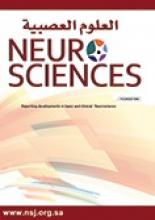Abstract
OBJECTIVE: To present our experience in operated meningioma cases regarding their prevalence, anatomical location, multiplicity, presenting signs and symptoms, and the possible correlation between MRI signal intensity and histological grades to set criteria for radio-pathological diagnosis.
METHODS: In this retrospective study, 120 operated meningioma cases in the Department of Neurosurgery, Jordan University Hospital (JUH), Amman, Jordan between January 1997 and January 2007 were reviewed. Our study included 90 cases, and their medical records, histopathological reports, and neuroimages were analyzed thoroughly.
RESULTS: Meningioma was more common in females than males with a ratio of 2.2:1. Para-sagittal meningiomas were the most common (23.3%). Multiple intracranial meningiomas were found in 4.4% of the cases. Most cases were of benign histopathology and exhibited iso-intense signals on T1 and T2, and appeared with hyper-intense signals on FLAIR with vivid enhancement.
CONCLUSION: The prevalence of meningioma among genders and its anatomical location at JUH corresponds to the published medical literature worldwide. There was no correlation between signal intensities (as seen on T1WI, T2WI, and FLAIR sequences), enhancement pattern on one side, and histological grades on the other side.
- Copyright: © Neurosciences
Neurosciences is an Open Access journal and articles published are distributed under the terms of the Creative Commons Attribution-NonCommercial License (CC BY-NC). Readers may copy, distribute, and display the work for non-commercial purposes with the proper citation of the original work.






